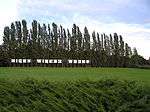Westerplatte

Westerplatte is a peninsula in Gdańsk, Poland, located on the Baltic Sea coast mouth of the Dead Vistula (one of the Vistula delta estuaries), in the Gdańsk harbour channel. From 1926 to 1939 it was the location of a Polish Military Transit Depot (WST), sanctioned within the territory of the Free City of Danzig (now Gdańsk).
It is famous for the Battle of Westerplatte, which was the first clash between Polish and German forces during the Invasion of Poland and thus the first battle of the European theater of World War II.
History
Resort
The resort was established on the Westerplatte peninsula around 1830 which had a beach, a forested park, an ocean-side bath complex and health spa facilities.
The transit depot
In 1925 the Council of the League of Nations allowed Poland to keep 88 soldiers on Westerplatte, which the Poles had secretly increased to 176 men and six officers by September 1939. They were armed with one 75 mm gun, two 37 mm Bofors antitank guns, four mortars and a number of medium machine guns. There were no heavy fortifications, but several reinforced buildings and guardhouses equipped with heavy weapons hidden in the peninsula's forest.
The Polish garrison was separated from Free City of Danzig (Gdańsk) by the harbor channel, with only a narrow isthmus connecting the area to the mainland. In case of war, the defenders were supposed to withstand a sustained attack for 12 hours after which a relief from the main units of the Polish Army were to arrive.
The Polish garrison's commanding officer was Major Henryk Sucharski, the executive officer was Captain Franciszek Dąbrowski.
Battle of Westerplatte

On 1 September 1939, only minutes after the German Luftwaffe (Airforce) had begun the invasion of Poland by dropping bombs in a series of raids on the city of Wieluń by Junkers Ju 87 Stukas, at 04:45 local time, the battleship Schleswig-Holstein, then on a "courtesy visit" to the Free City of Danzig, without warning opened fire on the Polish garrison. This was followed by an attack by Lt. Wilhelm Henningsen’s storm unit from the Schleswig-Holstein and the "Wehrmacht pioneers." However, soon after crossing the artillery-breached brick wall, the attackers were ambushed by the Polish defenders, with small arms, mortar and machine gun fire from concealed and well-positioned firing points that caught them in a crossfire. Another two assaults that day were repelled as well, with the Germans suffering unexpectedly high losses.
Over the coming days, the Germans repeatedly bombarded Westerplatte with naval artillery and heavy field artillery along with dive-bombing raids by Junkers Ju 87 Stukas. Repeated attacks by 3500 German soldiers were repelled by the 180 Polish soldiers for seven days. Major Henryk Sucharski had been informed that no help from the Polish Army would come. Cut off, with no reinforcements or chance of resupply, he continued his defense, keeping the main German force stalled at Westerplatte and so preventing further attacks along the Polish coast.
On 7 September the Major decided to surrender, due to lack of ammunition and supplies. As a sign of honor for the soldiers of Westerplatte, German commander, Gen. Eberhardt, allowed Major Sucharski to keep his sword while being taken prisoner.
Post-war
The ruins of the defenders' barracks and guardhouses are still there. After the war, one of the guardhouses (#1) was converted into a museum. Two 280mm shells from the Schleswig-Holstein prop up its entrance.
A Monument of the Coast Defenders (Pomnik Obrońców Wybrzeża) was unveiled in 1966.
-
Memorials to fallen soldiers.
-

Barrack ruins at Westerplatte.
-

Monument seen from the mainland
-

War: Never Again (Nigdy więcej wojny)
See also
- Karol Szwedowski
- The German invasion of Poland
- The Polish Army
- The German Wehrmacht
Further reading
Sources and documents
- Stanisława Górnikiewicz-Kurowska (red.) (1994). Znaki pamięci : listy westerplatczyków (1940-1993). "Marpress". ISBN 83-85349-21-9.
- Jacek Żebrowski (red.) (2001). Dziennik działań bojowych pancernika "Schleswig-Holstein" 8.09.-2.10.1939 r. Toruń: Wydawnictwo Adam Marszałek. ISBN 83-7322-123-9.
Guidebooks
- Franciszek Mamuszka (1988). Westerplatte : przewodnik historyczny. Warsaw: Wydawnictwo PTTK "Kraj". ISBN 83-7005-192-8.
- Rafał Witkowski (1989). Westerplatte : informator historyczny. Gdańsk: Krajowa Agencja Wydawnicza. ISBN 83-03-01772-1.
Fiction
- Mariusz Wójtowicz-Podhorski, Krzysztof Wyrzykowski (2004). Westerplatte: Załoga śmierci. Milton Media. ISBN 83-920878-0-1.
Other
- Zbigniew Flisowski (1982). Tu, na Westerplatte. Warsaw: Książka i Wiedza.
- Zbigniew Flisowski (red.) (1989). Westerplatte. Warsaw: Wydawnictwa MON. ISBN 83-11-07694-4.
- Maria and Zbigniew Flisowscy (1985). Bastion u wrót Gdańska. Warsaw: Nasza Księgarnia. ISBN 83-10-08779-9.
- Władysław Kluz (1989). Honor : mjr Henryk Sucharski. Warsaw: Akademia Teologii Katolickiej.
- Mirosław Gliński (1998). Westerplatte. Gdańsk: Muzeum Historii Miasta Gdańska : Wydaw. Gdańskie. ISBN 83-85843-76-0.
- Stanisława Górnikiewicz-Kurowska (1988). Lwy z Westerplatte. Gdańsk: Wydawnictwo Morskie. ISBN 83-215-7237-5.
- Stanisława Górnikiewicz-Kurowska (1999). Westerplatczycy : losy obrońców Wojskowej Składnicy Tranzytowej. Gdańsk: "Marpress". ISBN 83-87291-53-6.
- Andrzej Drzycimski (1989). Wojna zaczęła się na Westerplatte. Gdańsk: Krajowa Agencja Wydawnicza. ISBN 83-03-02403-5.
- Andrzej Drzycimski (1990). Major Henryk Sucharski. Wrocław: Ossolineum. ISBN 83-04-03374-7.
- Melchior Wańkowicz (1990). Westerplatte. Warsaw: Pax. ISBN 83-211-1113-0.
External links
| Wikimedia Commons has media related to Westerplatte. |
- A Song of the Soldiers of Westerplatte
- westerplatte.pl/
- Map of events occurring in Westerplatte
- Huge article about battle of Westerplatte
Coordinates: 54°24′27″N 18°40′17″E / 54.40750°N 18.67139°E